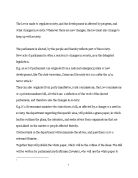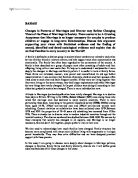We have seen, then, the legal and ethical standpoint of the mother as regards assisted reproduction, but what of the father? This is perhaps the most perplexing area when determining who the father is and what responsibilities he has. S28 of the HFEA 1990 provides the definitions for the father. By virtue of subsections (2) and (3) this section, where a man and woman are treated together and they either party to a marriage or they are a couple, then the man will be treated as the father of the child, even if his sperm has not been used in the treatment. The key factor here is that only male partners may be the father of the child, however following Goodwin v UK and the Gender Recognition Act 2004 S.9(1) a trans-gender individual may be regarded as the father of a child. Thus, it is clear from this that it is possible for a non-genetic male to be regarded as the father. In an ideal world, the best case scenario sees married couple, who wish to settle down with a family, receive assisted reproductive treatment and live happily ever after with their child. These cases are, unfortunately in the minority. The reality is that a number of scenarios can arise. For example, in the case of Re R (a child) (IVF: Paternity of Child) a cohabiting male and female entered into assisted reproductive treatment using the sperm of a donor, both having agreed to all the according consent issues. After a number of unsuccessful attempts, their relationship broke down and the female began to see another male. She continued to receive treatment; deceitfully using the consent of her initial partner and, upon successful treatment, the initial partner lodged a claim to gain parental responsibility which subsequently failed. This raises the question then, who should be regarded as the father of the child here? Clearly the court regarded that the initial partner could not be the father of the child. He had not lived with the mother for some time and they were not together at the time of treatment and therefore, he could not rely on S.28(3) of the HFEA. Moreover, the courts stated that it was not in the interest of the child for a family relationship to be founded on such deceit. On this basis the new partner could not be regarded as the child’s legal father as he had not consented to receive treatment with the mother. The final option is to turn to the genetic link (the donor) as the father. By virtue of S.28(4) of the HFEA the sperm donor of a licensed treatment is never to be treated as the father of the child, but this appears to be reliant upon subsections (2) and (3), which were clearly not satisfied in Re R. Ultimately, one can only assume that the child was left legally fatherless, a rather unethical conclusion indeed. It is worth noting here, however, that any child born after July 2004 may find out the identity of their sperm donor, but this does not negate the fact that the donor does not acquire responsibility.
Further ethical issues may arise where the child’s father, who supplied the sperm, has died before birth or treatment. Prior to the Human Fertilisation and Embryology (Deceased Fathers) Act 2003, the mother was prevented from putting the name of her deceased husband on the birth certificate of the child. This has subsequently changed and, provided that the donor was married or living with the mother at the time of treatment and he consented; and did not withdraw his consent; and the mother elected within 42 days of the birth to name him as the father; then no other person shall be treated as the father. This once again gives rise to a legally fatherless child.
It is thus clear that the field of assisted reproduction could throw up a myriad of scenarios that pose serious ethical, moral and social issues and once again they seem, in their majority, to pivot on the welfare of the child. Is it fair that a child should one day bear the onus of explaining to his classmates why he suddenly has “another” father? It would appear that the legislation requires a significant overhaul in order to resolve these ethical issues and this is addressed in the conclusion below.
Discussion must turn here to the Human Fertilisation and Embryology Bill. It must first be noted that this bill has, as of 13th November 2008 received Royal Assent and will become and Act of Parliament expected to come into force early in 2009. Questionably the most profound change under this Act is the recognition of same sex lesbian couples being recognised as the legal parents of a child. This effectively sees one of the women being recognised as the father – although actually termed as “the other parent” – and ultimately undermines the principle of S.28 of the current Act whereby only a man can be the father of the child. This is by virtue of sections 42-45 of the new 2008 Act. This is undoubtedly a landmark change that affords same sex lesbian couples an almost equal legal footing to that of married and cohabiting heterosexual couples and had this Act been in force prior to Re G (Children) (Residence: Same sex Partner) the outcome may have been slightly different and a conclusion easier to reach.
Finally, the discussion thus far has assessed situations where parentage is called into question by an act of one of the purported “parents”. But what about the ethical issues relating to reproductive technology arising from the actions of the clinic? A v Leeds Teaching Hospital NHS Trust is sui generis in nature. It concerned two families who signed up for reproductive treatment at the same time and, due to a mix up, one family resultantly gave birth to children that were fathered by the husband of the other family. Neither family had consented to the use of any other gametes but their own in their treatment. Therefore, the question arose as to who should father the child. While it was agreed that the child should continue to live with the family to whom the mother belonged, the court did not rule on who would be the legal father. This surely can only lead to that conclusion that the existence of a margin of error, even as small of this on the part of the clinic, which could cause such a dispute ultimately calls into question the whole existence of the availability of the treatment. However, one would agree that this argument could be countered by the right to a family life afforded under Art.8 of the European Convention on Human Rights.
In conclusion, it appears that while the legal issues arising from assisted reproductive technology predominantly call into question the parentage of a child, it seems obvious that the wider ethical issues appear to pivot largely on the welfare of the child. All disputes arising from the issues debated would ultimately have a negative affect on the child. In a society where statistics show that the irretrievable breakdowns of both marriages and relationships are on the up, so too must these negative effects on their children. How should this be addressed? One must argue that rather than focussing on altering the legislation so that same sex partners are placed on an equal footing and dead husbands can be fathers, the Parliament should be addressing the definition of the father. Perhaps the legislators should remove all opportunities for a child to be left legally fatherless. While this may pose a difficult task it must be concluded that it warrants paramount consideration.
Moreover, following the introduction of the aforementioned Human Fertilisation and Embryology Authority (Disclosure of Donor Information) Regulations 2004, it is understandable that perspective donors are as such going to be dissuaded from donating and, while it is no doubt in the interest of the child to be able to find out this information, one must agree that the lack of available donors will narrow the window of opportunity afforded to families seeking treatment. It could be suggested here that it should be for the donor to decide whether or not his information can, in the future, be disclosed to the child. It should be for the child only to apply and the donor should have the opportunity to change his decision at any time.
We have seen, then, that this topic is one of great triviality and as such can not be rectified overnight, but the legislation, as it is, still requires serious overhaul.
Word count: 2077
Bibliography
Booth, P, Is This a Fair Hearing for Parenthood or Childhood? (2002) Family Law 610
Dennison, G and Northover, A, Genetic Testing and the Impact on the Family (2002) Family Law 752
Feast, J, Embryological Secrecy Syndrome (2000) Family Law 897
Fovargue, S, Re R (IVF: Paternity of Child): assisting conception for the single infertile (2006) Child and Family Law Quarterly 423
Harris-Short, S and Miles, J, (2007) Family Law Text Cases and Materials, 1st Ed., Oxford: Oxford University Press
Sheldon, S, Fragmenting Fatherhood: The Regulation of Reproductive Technologies (2005) 68(4) Modern Law Review 523
Spon-Smith, R, The Man is the Father of the Child – Or is He? (2002) Family Law 26
Woodcraft, E, Re G: A Missed Opportunity (2007) Family Law 53
Per S.27 Human Fertilisation and Embryology Act 1990
Per S.1A of the Surrogacy Agreements Act 1985
See Re C (A Minor)(Wardship: Surrogacy) [1985] FLR 846, at 847-48
By virtue of the Human Fertilisation and Embryology Authority (Disclosure of Donor Information) Regulations 2004
Human Fertilisation and Embryology Act 2008 (information gathered from (04/12/2008))







